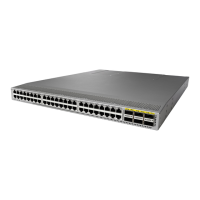CHAPTER 14
Configuring ERSPAN
This chapter contains the following sections:
• Information About ERSPAN, on page 147
• Licensing Requirements for ERSPAN, on page 149
• Prerequisites for ERSPAN, on page 150
• Guidelines and Limitations for ERSPAN, on page 150
• Default Settings for ERSPAN, on page 152
• Configuring ERSPAN, on page 152
• Configuration Examples for ERSPAN, on page 164
• Additional References, on page 165
Information About ERSPAN
The Cisco NX-OS system supports the Encapsulated Remote Switching Port Analyzer (ERSPAN) feature on
both source and destination ports. ERSPAN transports mirrored traffic over an IP network.
ERSPAN consists of an ERSPAN source session, routable ERSPAN generic routing encapsulation
(GRE)-encapsulated traffic, and an ERSPAN destination session. You can separately configure ERSPAN
source sessions and destination sessions on different switches.
ERSPAN Types
ERSPAN Type III supports all of the ERSPAN Type II features and functionality and adds these enhancements:
• Provides timestamp information in the ERSPAN Type III header that can be used to calculate packet
latency among edge, aggregate, and core switches.
• Identifies possible traffic sources using the ERSPAN Type III header fields.
ERSPAN Sources
The interfaces from which traffic can be monitored are called ERSPAN sources. Sources designate the traffic
to monitor and whether to copy ingress, egress, or both directions of traffic. ERSPAN sources include the
following:
• Ethernet ports and port channels.
Cisco Nexus 3548 Switch NX-OS System Management Configuration Guide, Release 7.x
147

